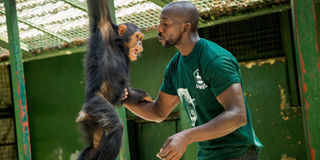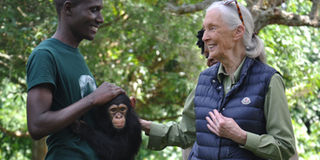Chimpanzee tourism can earn Uganda fortune, says a renowned conservationist

Ronald Wako, head of the primate section at the Uganda Wildlife Education Centre, helps to rehabilitate a rescued chimpanzee on June 9, 2018 in Entebbe. AFP PHOTO
What you need to know:
- Since 1991, the Jane Goodall Institute started in Uganda on a dramatic protection mission. In 1989 four chimps – Sundy, Masiko, Jim and Megan – were confiscated by local authorities and brought to Entebbe Zoo.
In September 1990, these four chimps were sent to Moscow supposedly to a zoo, but in fact ended up in the hands of an animal dealer. - The Jane Goodall Institute in the United Kingdom found out about this and with the help of International Primate Protection League, found the chimps in Hungary.
The Hungarian authorities confiscated the chimps for a second time in September 1991 and the four were flown back to Uganda under the condition that someone with expertise in captive chimpanzee care went with them. - The Jane Goodall Institute was asked to send a chimpanzee expert to accompany the chimps and to stay in Uganda and help support and train Ugandan personnel.
- Masiko, Sunday and Megan were originally released on to Isinga Island Sanctuary and in 1998 to their current island home on Ngamba Island in Lake Victoria. Their care precipitated the genesis of JGI in Uganda.
JGI Uganda has been a registered foreign NGO since 1996 though its headquarters is still in the USA.
Chimpanzees’ tourism has the potential to earn the country as much fortune as gorilla trekking, a celebrated chimpanzee researcher and a veteran conservationist has advised.
Dr Jane Goodall, also an ethologist, believes that the second most intelligent primate offers the country an opportunity that if harnessed properly could unlock the fortunes of tourism sector in a way not imagined before.
Latest statistics from Uganda Tourism Board shows that the country’s foreign exchange earnings from tourism were $1.35 billion which was about 23.5 per cent of the total exports.
In 2015, the country recorded a total of 1.7 million arrivals of which 1.3 million (75 per cent) were tourists arrivals.
Tourist arrivals have since grown from 1.15 million tourists recorded in 2011 to nearly 1.5 million recorded last year.
Although rare to find, Chimpanzees trekking provides terrifically exciting as well as fulfilling experience.
But first, she said: “It begins with preserving the wild chimpanzee's environment.”
Speaking ahead of the celebration to mark the 27 Years of The Jane Goodall Institute in Uganda, the 83 year-old ethologist, urged the communities in Uganda and other African nations as whole to develop nature-friendly tourism programmes, saying it is the only sustainable measure that will make it easy to tap into the lucrative wildlife resource.
And it is for that reason that she involved in working with business and local governments to promote ecological responsibility.
In an interview on Thursday at the Jane Goodall Institute in Lubowa, Wakiso District, Institute Programmes Director, Dr Peter Apell, said the major threat to the survival of the chimpanzees in the country is the encroachment of the primate natural habitat. This he said is by way of destroying the forest which is the natural environment of the Chimpanzees.
“The biggest challenge is the destruction of the environment. Once the Chimpanzees natural habitat is destroyed as a result of human activities they end up in the communities. And here they either injure or get injured,” Dr Apell said.
He continued: “But there are ways the communities can both survive without crossing each other’s path. First we must realise there are part of our heritage and we have a collective duty as a community to protect them. And this is part of the message we are trying to inculcate.”
It also emerged during the interaction with the journalists last week, that the kind of havoc the Chimpanzees can cause in the community can be minimized if they plant crops such as Chili pepper, sunflower and even Vanilla, all high value crops, as first line of defence will discourage the primates from finding their way into the communities in search of food.

Dr Jane Goodall (R) pats the shoulder of Zakayo II, heir to the late Zakayo as one of the animal keepers Bruce hold's him on June 9, 2018. Photo by Paul Adude
Save them from extinction
“I’m determined my great grandchildren will be able to go to Africa and find wild great apes,” Dr Jane Goodall was quoted in a press statement issued by the Jane Goodal Institute
This statement briefly presents the raison d’être of the Jane Goodall Institute (JGI) for wildlife and habitat conservation, research and education.
The Institute which is celebrating nearly three decades in Uganda exists to reverse the decline in the population of Great Apes and to preserve their habitats.
“Grounded in the legacy of Dr Jane Goodall’s 46 years of chimpanzee research and advocacy, JGI is committed to addressing the complex issues that threaten chimpanzees in the wild, while also meeting the needs of the surrounding communities and affected stakeholders,” reads the press statement.
It further continue to read: “Our primary interest is the conservation of the endangered chimpanzee as well as the welfare of those recovered from captivity. We work with the Uganda Wildlife Authority; Chimpanzee Sanctuary and Wildlife Conservation Trust; Uganda Wildlife Education Centre; Wildlife Clubs of Uganda; National Forestry Authority; Ministry of Education and Sports and many others in our efforts to protect and conserve the diminishing chimpanzee populations of Uganda.”
There are about 5000 Chimpanzees in Uganda, according to studies done in 2002. In 2009/10 according to Dr Apell another study was carried out and it indicate the population of the Chimpanzees as stable, meaning population numbers of the second most intelligent primate is still in the range of 5000 or thereabout.



